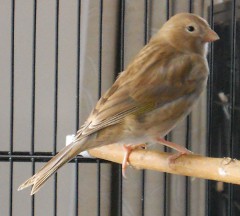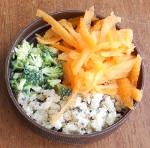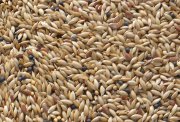Canaries
Contributions, research and write up by Israel. Page is a work in progress.

|
|
A Red Factor Canary. She's gone the apricot colour from eating lots of carrots. |
Walk into the bird section of a pet shop anywhere and you are guaranteed to see Canaries for sale. Popular for their song and beauty, they they have long brought joy to many, have a rich history, and can be found in many aspects of our culture. Originating from the Canary Islands, the bird we have now has changed much from its wild cousin, the green Wild Canary.
DID YOU KNOW:
Only the male canary sings; hence they are the more popular sex for being kept as a pet.
The common domestic canary goes back at least 400 years, being bred at first by monks in Spain and Portugal (who only traded away the singing males, probably in order to keep a dominance on the market for the birds), before someone eventually managed to acquire a hen in Italy, and canary breeding started to spread out across Europe. By the seventeenth century the canary trade was booming, and over time, as people started to care a bit more about what birds they had, different varieties started to appear. In the Harz Mountains of Germany where miners kept canaries, in the late seventeenth century, the Roller Canary was created by years of selective breeding and care. While those in Europe took a focus in the songs of the canaries, the British were more interested in type and posture, and are responsible for many of the type Canaries we now have.
And somewhere along the line, most likely with British settlers (like all the British Birds!), Canaries made their way to New Zealand.
Sexing Canaries

|
| Yep. She's definitely a female. |
There is only one definitive way to sex canaries - Males sing, and females lay eggs. There is no difference in markings or colour. Of course, there can be many other indicators that can help sex the canaries before you are able to say for certain, some more reliable than others, but remember that there are always exceptions. Males fight, even at a young age, and may court a new female addition to the cage. Females may practice nest building and or sitting. Every breeder will be able to tell you their tips and tricks for determining the sex of the chicks. Remember - Observation is the key.
Varieties
Canary varieties can be split into three broad (show) categories - Those that are breed for colour & markings, those that are breed for type, and those bred for song.
- Roller
- Border
- Norwich
- Glosters
- Lizard
- Yorkshire
- Colour Fed (Red Factors)
- Non-Colour Fed
DID YOU KNOW:
The first recorded appearance of a Recessive White canary was in 1908, in New Zealand! (to a Miss Lee).

|
|
Colour fed red factor canary. Notice how much deeper his colour is than the carrot fed female above. |
In the Colour canaries, Red factors' can come in all the different colours, but in NZ very few of the colour breeder's bother with the reds in Isabel, Pastel and Agate. A few Bronze are breed but these days that is all. The Non-Colour Fed section includes the Classic colours, New Colours, and any mutations of the type breeds. The classic colours are green, cinnamon or fawn, which are found in all type birds. The new colour canaries are those that fall out side of this: Agates, Isobel's, Pastels, Ino and Satinettes. (Many thanks to Monty for this information).
The term 'Red Factor' refers to the gene that the birds carry, that reacts to Canthaxanthin and Beta-Carotene, and causes their feathers to go a red-ish colour after molt. Carrots are high in Beta-Carotene, and will cause red-factors to change colour (usually just a orange colour).
For a more complete (but not exhaustive) list of the different colour varieties in canaries, along with the associated names and descriptions, there is an article in the articles section on the genetics of colour canaries which can be directly accessed here.
DID YOU KNOW:
Variegation is the dark feathers (brown &/or black) that can appear on any canary. Variegation can fully cover the bird (it's wild state), be absent (clear) and anywhere in-between. Variegation is separate from colour, and can appear on any of the three base (ground) colours for canaries - Yellow, White & Red.
|
|
|
|
|
|
|
|
Behaviour
Canaries are energetic birds, full of personality and individual quirks. They can be kept in small or large numbers, and they are social to a degree. When kept as a pet in a household it is not uncommon for a family to only keep one bird, and they will fare fine, though they do appreciate the company of their own kind. Some canaries will get along with their peers better than others, and in any setting where multiple are kept a pecking order will develop, where one bird, usually a male, will take the dominant position. There can (and probably will) be some squabbling till the order is worked out, but after that they will usually settle down.
Males, when kept together in enclosures smaller than aviaries, will often fight, especially during the breeding season. Again, this is to determine the pecking order, and also who is the better male, and often only the dominant male will sing. When singing, males stand up straighter and puff out their throat, forming a song to impress the ladies, sometimes doing a little dance at the same time, or chasing the prospective mate around the enclosure. Singing can be targeted at a female in heat, but they will also sing just because they can, to compete with another male singing, or to compete with a background noise (such as music). Females don't sing, though they do chirp and chortle. Tom-boys have been known to try their best to imitate a song, which is not dissimilar to young males learning to sing.
Canaries are curious creatures creatures, and will investigate and play with toys when provided, especially bells, swings and thread (particularly for females). Bathing is a favoured activity, and when provided with clean water in a vessel large enough it won't take long for them to start splashing water everywhere. It is not uncommon to see multiple canaries taking baths at the same time, and it can often have a domino effect, encouraging other canaries in the same area to also do the same. Bathing is important for birds, as it allows them to clean their feathers, getting rid of irritations and helping to maintain better feather quality, especially so during the moult.
Once they get beyond the initial fledging state, canaries are at best wary of humans, and will do their best to avoid being caught or be in to close proximity to the large creatures that frequent their area. Cages provide a sense of security for them, and while that barrier is between you and the bird you can get quite close to them, but once it is gone personal space becomes much more important, and fly away they will.
Diet
Canaries are primarily seed eaters, though they will eat greens and fruits as well. Pre-made canary mixes can be brought, but it is essential to make sure that the mix is predominately made up from Canary Seed (NZ grown), as this is their staple.
DID YOU KNOW:
In addition to their seed staples of Canary Seed, Rape, Linseed and Millet (more of the former, less of the later, and Rape being a particular favourite), Canaries quite happily eat (and benefit from) a varied diet including soft food, vegetables and fruit. All birds have different tastes, but trying your canaries out on carrot, broccili, salad greens (excluding iceberg lettuce), apple, and chickweed is well worth the effort.
|
|
Breeding
Nests
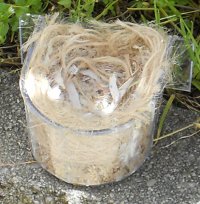
|
| Nest built in a seed dish. |
Like all birds, canary hens can be picking about where they'll lay their eggs. In breeding cages, they'll usually settle for what is provided, but in a larger aviary it is often a good idea to provide a few alternative locations as they'll appreciate the choice. Canaries prefer open top nests, like plastic or wicker baskets, though often they'll also decided that the seed dish is where they want to lay their eggs. The skill level differes between hens, but they will usually go to the effort of weaving whatever materials they can find into their nest - twine and grass is readily accepted, newspaper will be wetted and shredded to provide a base, and loose threads will be pulled at in the hope of coming loose. Providing a nest liner in the nest gives the hen a kick-start on building her nest (though hens have been known to just throw in a few threads and call it done). Cotton wool is prized by hens for their nests, and fights will break out over it, but it should not be provided as it can cause complications and fatalities in the nest to the chicks.
DID YOU KNOW:
Some hens are very keen nest builders (and breeders), and as soon as their young chicks start to fledge they will start building a new nest in whatever location they find suitable. They will often shred fresh newspaper, take nesting material from the old nest (even if some chicks are still in it), and in extreme cases even pluck the feathers from their young! When they start this behaviour, if you want them to raise another clutch, then nesting material should be provided.
Clutches
The rearing of young can be quite taxing on the parents, especially if they have a full clutch to feed (more chicks to feed equals less food for the parents), so the number of clutches a female should be allowed should be limited, least you risk losing them during the breeding season from exhaustion (they can drive themselves into an early grave!). Although some pairs are keen to lay 4+ clutches of eggs, the recommended amount seems to be around 2. This is of course dependant on how many chicks hatch and are successfully raised in each clutch, and also varies from breeder to breeder.
The number of eggs laid in a clutch is around 3-5 eggs, and the hen doesn't start seriously sitting on the eggs till close to when her clutch is full. Some breedres may remove the eggs, replacing them with dummy eggs and returning them to the nest once the final egg is laid to ensure that all the eggs hatch at the same time. The incubation period is 12-14 days, sometimes longer, with 17 usually being the max.
Rearing the Young
Once the chicks have hatched, it is important that the parents be provided with a food source that is high in protein to feed to their young; Protein is essential to the chicks growth! There are many options available, but it is good to have already gotten the birds use to whatever your choice is before breeding season so that they will actually take to the food. One of the simplest options is to mash (or blend) boiled egg (boiled for 15 minutes) with softfood, and serve this to them. It is suitable for small numbers of birds, but once you get to the aviary scale recipes like this one here are more suitable and can be produced on a large scale with less effort. No matter what rearing food you choose success can vary, sometimes even from circumstances and conditions that you aren't aware of. As always, make sure there is a variety of foods available, with plenty of seed too. Both males and females will help feed the young, and often the male will also feed the female while she is sitting on the young.
Once hatched, chicks grow up very fast. Below are a selection of images showing growth in the nest, from 3 days old to fledging. Canaries generally fledge (leave the nest) sometime between 2-3 weeks old, depending on how much food they have managed to consume, and how many siblings they are competing with. They are usually weaned (separated from their parents) at about 5 weeks or more, once they are able to feed themselves reliably, though at this age they will still beg their parents for food, chasing them around the cage and squawking for food when they are near.
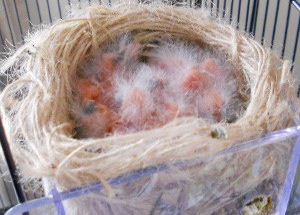
|
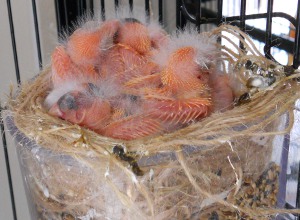
|
| Hatchlings at 3-5 days old | Hatchlings at 6-8 days old |

|
| Hatchlings at 10-12 days old |
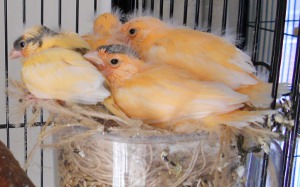
|
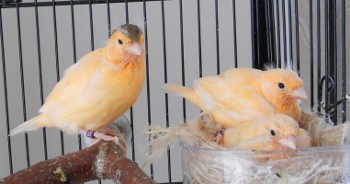
|
| Hatchlings at 13-15 days old |
Hatchlings at 16-18 days old. All but one has fledged, although some are still returning to the nest to get fed or sleep (all five piled into the nest that night, where as the night before two slept on the perch). |
DID YOU KNOW:
Hens may attempt to pull bands off the chicks legs, and succeed, if they are put on too early! They'll consider it to be foreign to the nest (or poop) and throw it out once the manage to yank it off their babies leg.
Feeding duties vary from pair to pair, but it is usual for both parents to feed the young, especially when the hatchlings are still in the nest. Once they fledge however, it is not uncommon for the hen to lose interest in the young as she contemplates her next clutch, leaving the feeding duties to the father till the young chicks learn to eat themselves. Hence, if needed, the chicks can be removed from the cage, as long as the father goes with them to keep looking after them till they are weaned.
Banding of the chicks is at around 4 days. It is dependant on the size of the chick, as growth rates will vary, and the chick needs to be small enough that the band will fit on, but large enough that it won't slip off (or be taken off). Chicks have rapid growth, and experience is they key for being able to judge. When the chick starts pooping over the side of the nest is often a good indication that they are ready (which is around the four day mark); before that the hen usually clears it out of the nest to keep it clean. A purple band can be seen on the left most chick in the right hand photo above.
Notes about selecting Pairs
There are two types of feather types in canaries - Yellow (non-frosted/intense) and Buff (frosted) , though both types have many different names. Yellow feathers (type, not colour) are narrow harder feathers, with the intense colour going right to the edges. Buff feathers are softer and wider, with softer base colour, and have white tips (hence the term frosted). Both feather types have range, as to how soft/intense they are.
When pairing canaries, you want to pair buff with yellow, and avoid continual pairing of buff with buff (double buffing) where possible, as this can lead to softer feathers and feather lumps, which are unsightly and can cause complications for the birds. Buff with yellow helps maintain good feather quality.
With Gloster pairings it should always be a Gloster Corona to a Gloster Consort. Pairing two coronas together results in a 25% lethal factor being present in the chicks (i.e. each chick has a one in four chance of dying in the egg)! This factor can also be an issue when pairing two white based birds together. A number of sources also say that pairing intense to intense gives rise to the lethal factor, killing a number of the young during the egg development (more on detail on lethal factors can be found in the genetics article here).

|
| Two very different canary chicks. Left: Apricot Bronze Right: Satinette. |
DID YOU KNOW:
The yearly cycle for canaries is influenced by the length of the day/sunlight hours. When the days start to lengthen after winter (a.k.a spring) the hens come into season. Once the day length reaches its peak and starts to go down and the days are warm canaries start to moult. Because of this, their cycle can be influenced with artificial lighting, causing them to breed or moult of of season. Therefore, pet canaries should have their light/day length matched to the natural daylight cycle for their well being.
Mules
A Mule is the result of cross breeding Canaries with British Birds, usually Greenfinces or Goldfinches . Mules are infertile, but are hardy birds, larger than their parents and live for longer. The Dunedin Bird Club has had moderate success with breeding Mules, with Monty Wright being our expert on the matter and having successfully bred quite a number thus far (100+). Mules have their own category in bird shows (Best Mule or Hybrid), and are well worth the effort it takes to breed one.
DID YOU KNOW:
One cross-breeding endeavor does produce fertile offspring - first bred in the 1930's, the mating of the Red Siskin with the Yellow Canary is what gave rise to the first Red Factor Canary!
Showing Birds

|
| Prize winning Norwich canary. |
One of the major pulls for breeding birds is the ability to be able to show them in annual shows in competition with the birds of other breeders, to see whose bird is the best, and canaries are no exception. Depending on the region your club is in, and the size of the club, there can be anything from a big annual and national shows held locally or nearby with specialist body patronage to more casual young bird shows and the like, a chance to practice before the big events.
So what makes a show winning bird? It varies from variety to variety for canaries (as they are shown in different categories), with the specifications laid out in the federation yearbook, along with the specifications for the type of show cage that must be used for each variety of bird as well. Song type canaries (Roller Canaries being the only ones in NZ) are judged based solely on their song, while colour canaries (new colour and red factor canaries) are judges based on their colours and patterns. Lizard canaries (a type canary) are judged based on their patterns, and the the rest of the type canaries (glosters, borders and norwich) are judged based on their body shape and features primarily. Each judge is likely to have their own preferences and methods, but in the end it should come down to the specifications listed in the yearbook.
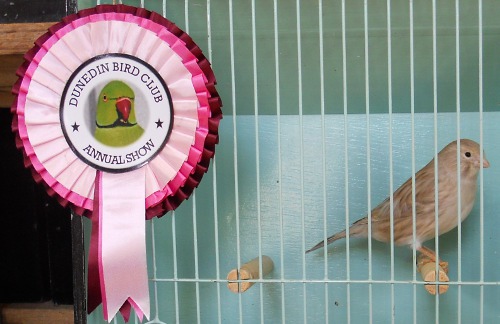
|
| Prize winning Fawn new colour canary. |
